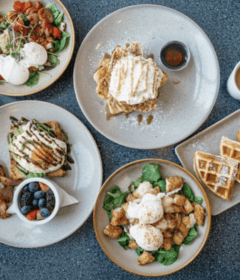The Most Popular Steaks
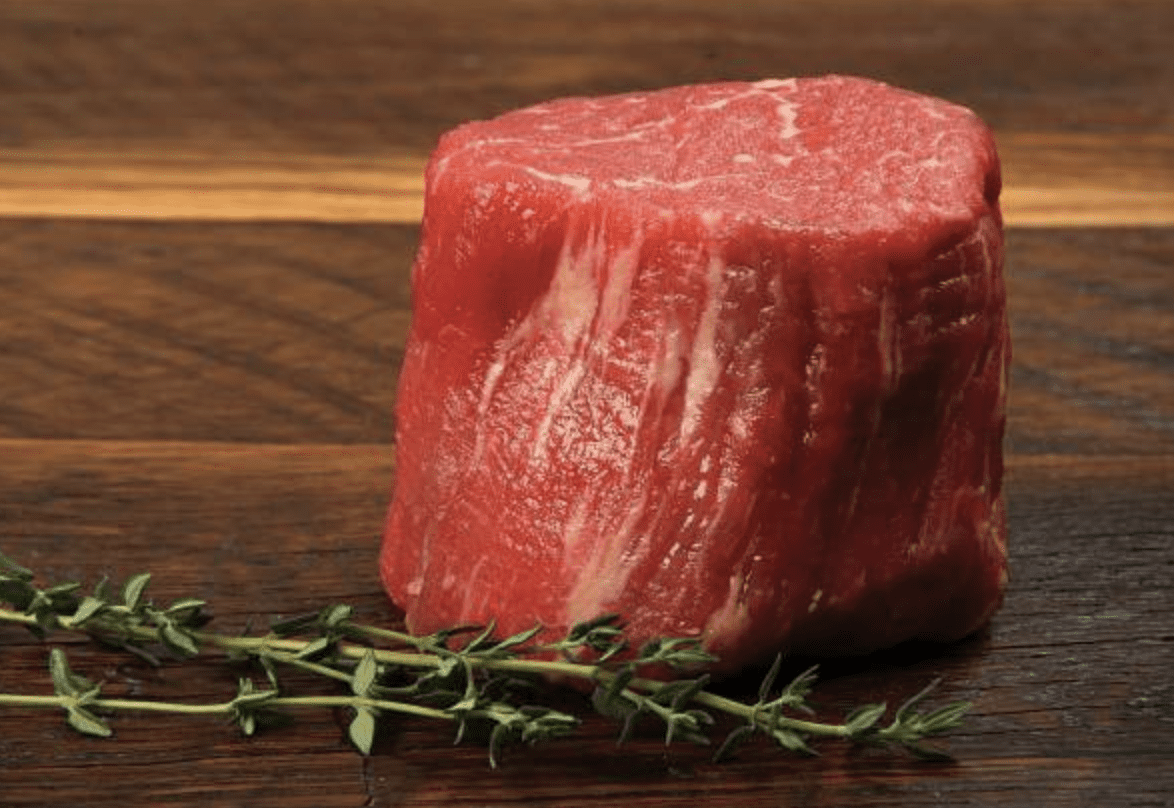
The Most Popular Steaks – Filet Mignon
Filet mignon is French, with filet meaning “thick slice” and mignon meaning “dainty.” This cut comes from the small end of the tenderloin which is found on the back rib cage of the animal. This area of the animal is not weight-bearing, thus the connective tissue is not toughened by exercise. The result is extremely tender meat.
Filet Mignon is cut from the tenderloin which is small, tender and usually the most expensive cut of steak. It’s best to cook filet mignon for a short amount of time so it doesn’t dry out.
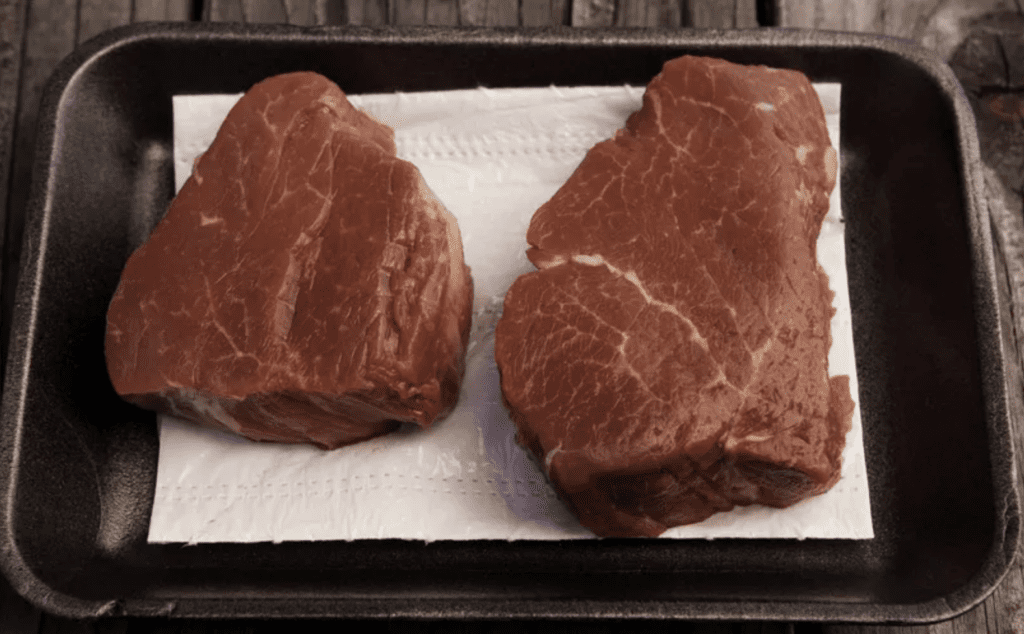
Selecting Filet Mignon
Look for USDA choice and prime grades. The prime grade has the fattest marbling, which makes it the most tender and flavorful. However, the prime grade is best found at high-end butcher shops and will cost the most. When selecting tenderloin or filet mignon slices, choose the lighter-colored ones over dark red as this indicates more marbling. Select steaks of the same shape and thickness for consistency of cooking, especially when cooking them at the same time. The steak should be firm to the touch and there shouldn’t be much red liquid in the packaging.
Some people prefer grass-fed filet mignon because the raising methods are considered more humane and sustainable. As well, there are differences in the nutrient composition of the steak. However, grass-fed beef usually has even less fat marbling than grain-fed or corn-fed beef, so it may be less tender. There can also be a difference in flavor, with some people preferring grass-fed and others preferring the other raising methods. Grass-fed beef will usually cost more as well.
Cooking Filet Mignon
Although filet mignon is very tender, the beef flavor is proportionately lessened. As such, it is often served with an accompanying sauce incorporating the pan juices, or with compound butter. It may also be marinated, smoked, wrapped in bacon, or seasoned with a rub.
Filet mignon can be cooked in a variety of ways, including grilling, broiling, roasting, smoking and pan-frying. Usually, high heat is first applied to sear the meat on both sides. Then it is transferred to lower heat to finish the steak to the desired doneness.
The Most Popular Steaks – Flank Steak
Flank steak is a long, flat cut of meat taken from the belly of the cow. Although this cut is quite flavorful, it tends to be tougher than other cuts of beef. It’s best when marinated, cooked over high heat like a grill or slow braised, and sliced against the grain.
Flank steak is technically not a steak at all. Instead, this popular cut of beef comes from the cow’s belly muscles. It’s a flavorful piece of meat, but is very lean, containing almost no fat. Despite its toughness, it can be a tasty and tender if you learn how to prepare it properly. Flank steak is enhanced through marinate and is best enjoyed grilled over high heat or slow-braised.
Flank steak comes from the cow’s lower chest or abdominal muscle, and is an inexpensive, flavorful, and versatile cut of beef. It’s about a foot long and one inch thick, and cooked whole rather than divided into smaller individual steaks. The cut is also known as jiffy steak, bavette (in French), and in some regions, London broil. Flank steak can be identified by the visible direction of the meat’s cross-grain.
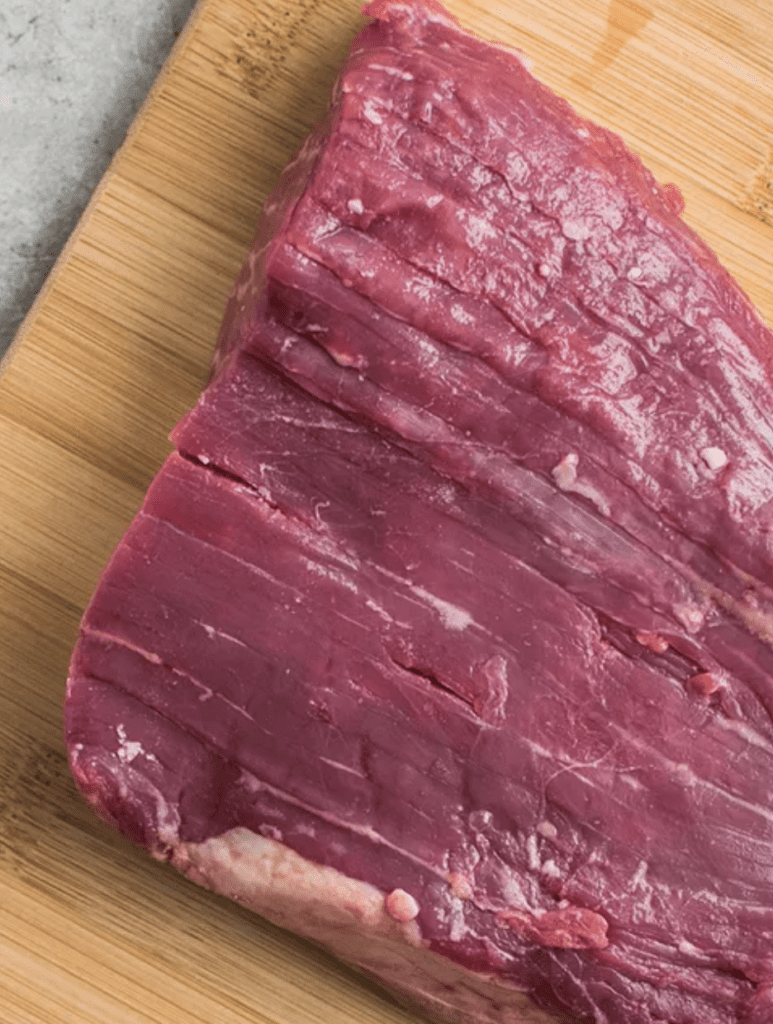
How to Cook Flank Steak
Due to flank steak’s low fat content, it does not need to be trimmed. It can be seasoned simply with salt and pepper or your favorite meat rub, and typically requires additional tenderizing in order to achieve the best flavor. This can be done by hand with a meat tenderizing mallet, chemically using an acidic marinade, or by cooking the steak “low and slow” to gradually break down its connective tissue.
Flank steak is ideal for fajitas, stir-fries, and other applications that call for beef strips. Rest cooked steak for at least five minutes before serving, and slice thinly across the grain, preferably at a 45-degree angle, for the best texture. Slicing with the grain will result in an unpleasantly chewy steak.
Selecting Flank Steak
You can buy flank steak in grocery stores with a well-stocked refrigerated meat section, and at butcher counters across the country. Since this cut is not always available at all butchers, you may want to call ahead to check. Flank steak is sold by the pound, and servings vary: One flank steak can weigh between one and four pounds. Choose a steak that’s uniform in thickness to avoid overcooked ends. Flank steak can be bought in bulk, vacuum-packaged, and can be frozen up to a year.
The Most Popular Steaks – Hanger Steak
The hanger steak belongs to a category of beef known as the flat steaks, which also includes the flank and skirt steaks. The hanger steak hangs (hence the name) between the rib and the loin, where it supports the diaphragm. It was originally known as a “butcher’s steak” since butchers kept and enjoyed it for themselves as consumers didn’t know to ask for it, but is now a somewhat standard cut of meat in supermarket meat departments. Hanger steak is best marinated and grilled and is often the type of meat found in steak tacos.
Hanger steak comes from the lower belly of a heifer or steer and is comprised of a pair of muscles that make a sort of v-shape. Although there is a long inedible membrane running down the middle, hanger steak is often the tenderest cut of meat.
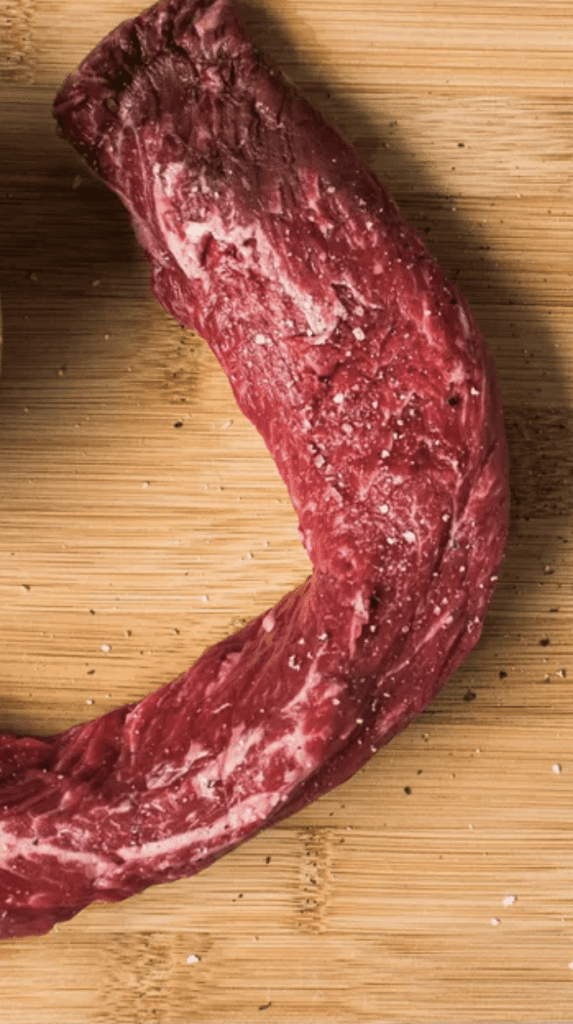
How to Cook Hanger Steak
Because the hanger steak comes from a supporting rather than active muscle, it yields more tender meat than the skirt or flank. Do note, however, that the hanger steak can get tough when improperly prepared; the tenderness suffers when exposed to dry heat for a long time. This steak fares best at medium rare cooking; anything above medium can make it tough.
Before grilling or broiling a hanger steak, use a marinade with a strong acid component (such as citrus juice, vinegar, or wine) for added moisture and to help tenderize. Then cook the steak hot and fast to 125 to 130 F; it will continue cooking once you pull it off the heat. To develop a nice crust, place the hanger steak over direct heat on a grill in a broiler 2 to 3 inches from high heat, or in a smoking hot skillet on the stovetop.
Always cut against the grain when serving a steak. The grain of a hanger steak runs perpendicular to the length of the meat, so you will need to first cut the steak it into short sections (roughly thirds or fourths of the length), and then turn them 90 degrees and cut across the grain into thin strips. The strong fibers in this cut can be chewy; cutting it this way makes it tender and easy to eat.
Selecting Hanger Steak
Generally, hanger steak is sold in the U.S. as a budget cut of meat, but the increasing popularity of hanger steak both among restaurant chefs and home cooks means it’s no longer quite the bargain—but it is still an affordable and versatile cut. You should be able to find packages of hanger steak in the meat section of your supermarket or at your local butcher.
The Most Popular Steaks – New York Strip Steak
The strip steak, also called a New York or a Kansas City strip, is considered among the higher-end cuts of beef, along with the filet mignon, the rib-eye, and the porterhouse or T-bone steak. The strip steak comes from the beef short loin subprimal, and it starts off with a short loin that has had the tenderloin removed, to produce a bone-in strip loin.
A New York Strip steak is similar to a porterhouse or a T-bone steak, but without the filet or tenderloin attached. This flavorful cut of meat is ideal for grilling or broiling and is a favorite of steak lovers.
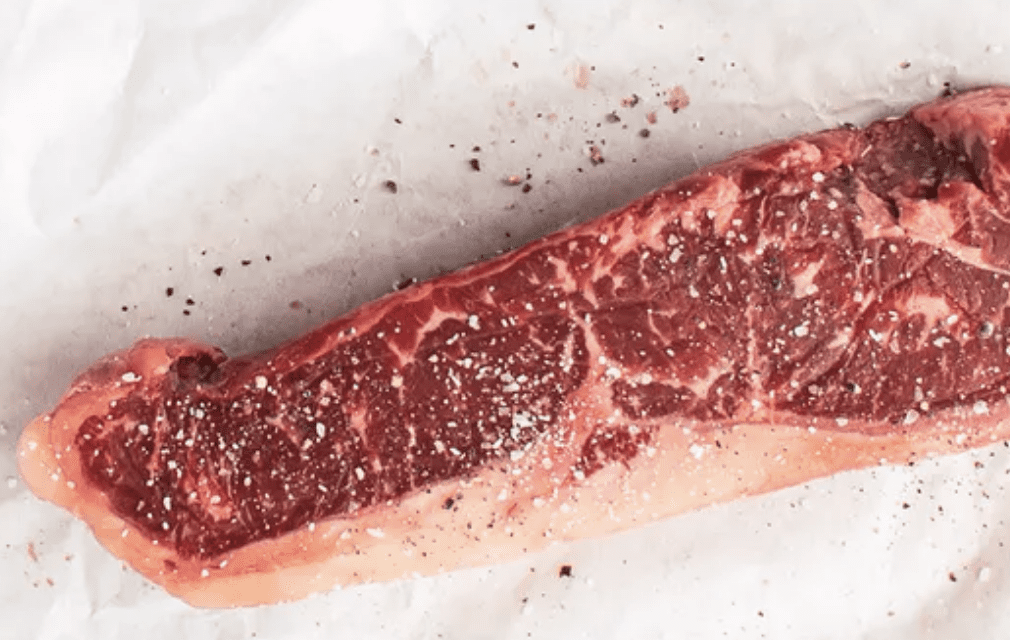
How to Cook a NY Strip Steak
Strip steaks are easy to cook on the grill, under the broiler, or in a cast-iron skillet on the stovetop. You can also sear them in a skillet and then transfer it to a preheated 425 F oven to finish cooking.
Let the steaks come to room temperature on the counter for at least 30 minutes before you cook them so they cook evenly. Pat them dry with paper towels so you can get a good sear quickly. And don’t be afraid to use some butter with this leaner cut.
Selecting a NY Strip Steak
Whether you buy strip steaks pre-packaged at the grocery store or freshly cut from a butcher, look for the ones cut from the rib end or the center of the strip loin. It’s easy to tell the difference by looking at the shape of the steak.
Look for a cut that’s wide and relatively straight, without much difference in width from top to bottom. The fat around the edge should be trimmed to about 1/8 of an inch all the way around. Avoid steaks that are kind of wavy, or shaped like a question mark, or have one end that is substantially more narrow than the other. These are from closer to the sirloin end and less desirable.
Indeed, you might even see something called a “center-cut” strip steak, which sounds like it must be from the center. But all it means is that it can’t be the last one from the sirloin end. The worst you can get with a center-cut strip steak is one that has a small piece of the gluteus medius, but it won’t be visible on both sides of the steak.
The Most Popular Steaks – Porterhouse Steak
This steak is a combination of two parts: strip steak and tenderloin. This large steak is cut from the back, below the ribs and contains a large, t-shaped bone. Porterhouse steak is similar to a T-bone steak but generally has more tenderloin filet attached. It’s popular at steak houses for its large size, and is typically seared before finishing in the oven or on the cooler side of the grill.
The porterhouse is a composite steak that’s derived from the point where the tenderloin and top loin meet. If you remove the bone and cut out the two steaks that make up the porterhouse, you get a tenderloin steak and a top loin (or New York strip steak).
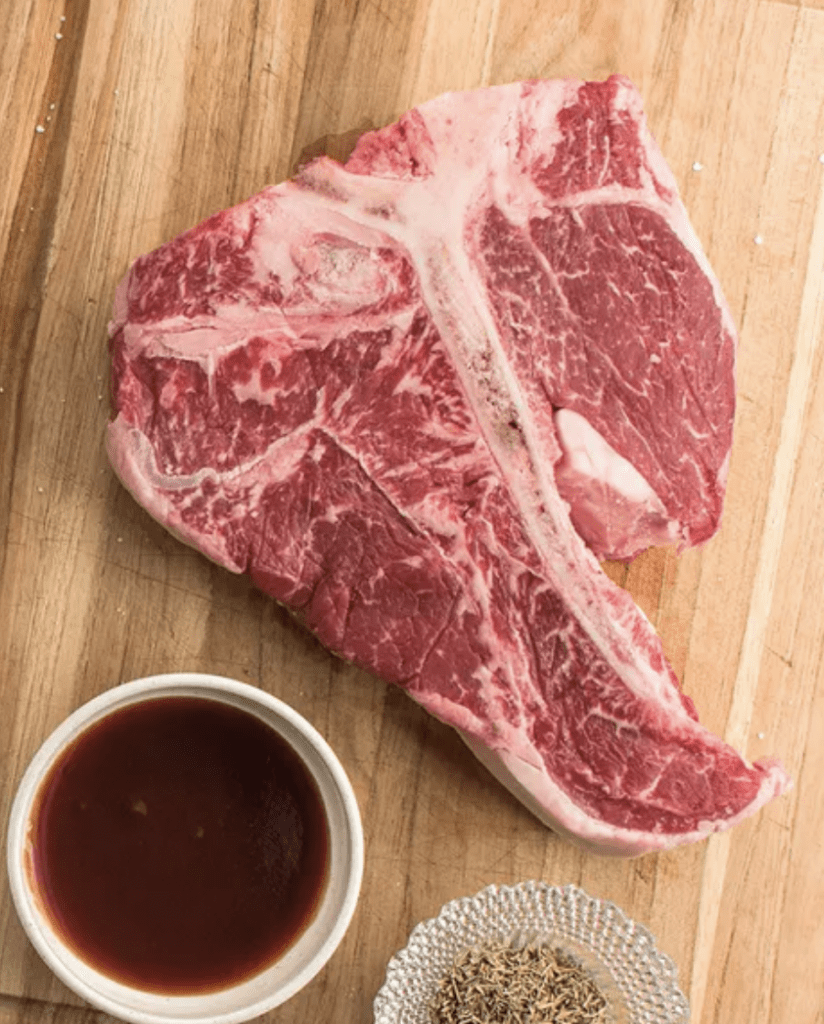
Cooking a Porterhouse Steak
For the most authentic steakhouse flavor, cook your porterhouse on the grill. But you can also get great results with the broiler or in a smoking hot cast iron skillet on the smoker or on the stovetop. Use light seasoning but a generous amount of salt and try not to cook the steak beyond medium, or 145 F, at the most.
To grill a porterhouse, start hot and fast, giving the surface a good sear. Cook it to the point right before the fat would start to burn, then flip it and sear the other side. To get those restaurant-style diamond grill marks, rotate it 45 degrees on the same side before you flip it and repeat on the other side.
Once it browns on both sides, move it to a cooler part of the grill to finish it to your desired doneness. To add richness, place a pat of butter in the center of the steak a few minutes before you pull it off the grill. This is a popular restaurant trick that brings out the flavor.
Selecting a Porterhouse Steak
When buying a porterhouse steak, look for one cut at least 1.5 inches thick. Occasionally, butchers will sell “thin” cut steaks, but these are largely pointless. A porterhouse should be thick, and not just because it is a huge steak and deserves to be so. In order to get a large steak like this cooked to perfection without it drying out, it needs to have significant mass and thickness.
A good porterhouse should have a deep, rich color without any gray. The fat should be white and not yellow. Look for good marbling throughout the meat, particularly the loin portion. Don’t try to get a bargain on a steak like this. While dry-aged and/or prime grade versions of the porterhouse will be expensive, you can find a good “choice” grade steak that is fresh and very flavorful.
The Most Popular Steaks – Rib Eye Steak
Rib Eye steak is cut from the ribs of the cow and contains a high amount of marbled fat, which makes it tender, juicy, and flavorful. Rib-eye steaks are can be grilled or roasted in the oven to soften the fat and connective tissue. The large amounts of fat can cause flare-ups when grilling, so it’s best to keep a close (but not too close) watch.
Rib-eye steak is considered one of the best steaks on the market. The rib-eye is cut from the roast—known as a prime rib or standing rib roast—that sits at the top of the rib primal, the part of the cow between the chuck and the loin. The rib-eye is basically the meat between each of the ribs, which makes it a boneless cut; it is best grilled or broiled.
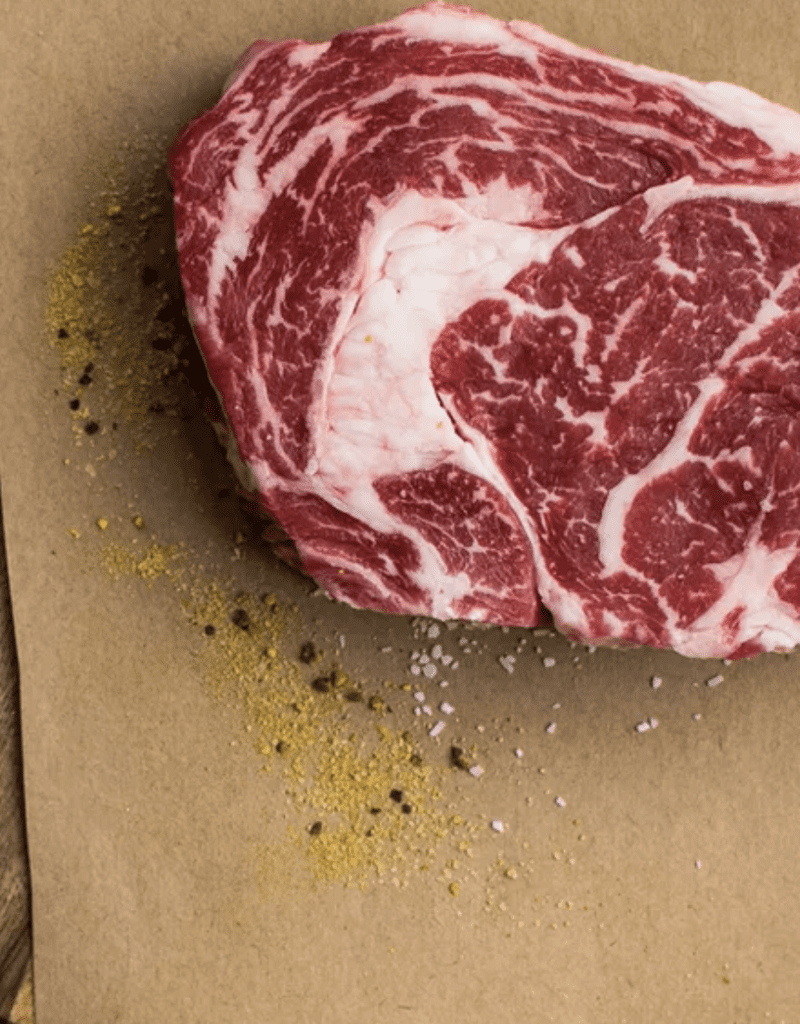
The generous amount of marbling (fat running through the meat) makes for a rich taste and juicy finish. Because this area of the cow gets little exercise, the muscle isn’t used much and therefore the meat is nice and tender. Rib-eye is often a decent size, filling up the plate, making for an impressive steak dinner.
How to Cook Rib Eye Steak
The grill or the broiler is the preferred cooking method for this cut of meat. The rib-eye is best cooked to rare or medium rare but will remain tender when cooked to medium (and is still good at medium well). Because of the steak’s excellent flavor, the rib-eye does not require much in the way of seasoning beyond salting. It should be brought to near room temperature before cooking and salted liberally just before it goes on the grill or under the broiler.
Since this steak has a higher fat content, it is prone to cause flare-ups while grilling; it’s important to keep a close eye on the cooking process, which should take no more than a few minutes. Move the steak to a new section of the grill every time you rotate (for those attractive grill marks) or flip over the meat, which should be every minute, up to 4 minutes total for rare to medium rare. To reach higher levels of doneness, reduce the heat or move the steak to a cooler section of the grill to continue cooking to the desired doneness.
How to Select a Rib Eye Steak
A reputable butcher may be the ideal spot to pick up a rib-eye, so you know you are getting a truly prime piece of meat. Otherwise, you should be able to find rib-eye steaks at your local supermarket in the meat department, as well as online beef purveyors. Just be prepared to pay a bit more per pound than your average steak.
The term “rib-eye” is quite universal, but depending where you shop it could also be labeled as Beauty Steak, Delmonico Steak, Entrecôte, Market Steak, Spencer Steak, and Scotch Fillet (in Australia and New Zealand). A rib steak is the same cut as a rib-eye but includes the bone.
The Most Popular Steaks – Skirt Steak
Skirt steak is cut from the diaphragm of the cow and can be further divided into inside or outside skirt steak. Both are a flavorful, thin cut of meat with lots of connective tissue. It’s best cooked quickly over a hot grill and sliced very thin against the grain.
Skirt steak is one of the most flavorful cuts of beef, and even though it’s also one of the tougher cuts with a lot of connective tissue, it’s still a great steak for grilling. Skirt steak comes from either of two separate muscles inside the chest and abdominal cavity, below the ribs, in the section of the cow known as the beef plate primal cut.
Inside and outside skirt are pretty similar; both are long, flat muscles with very thick grain that runs across the length of the muscle. These narrow pieces of meat can be about 20 to 24 inches long and three to four inches across once they’ve been trimmed.
Because there are only two skirt steaks per side of beef, one inside and one outside, pretty much every outside skirt from every side of beef ends up in a commercial kitchen of some kind. So when you see skirt steak at the butcher shop, it will almost always be an inside skirt.
Outside skirt is encased in a membrane which needs to be removed before preparing it. If the meat has been dry-aged, that membrane will be like paper and will peel off pretty easily. With wet-aged meat, the membrane will be wet, and it’s a little bit trickier to peel it off without tearing the meat. A good butcher will have peeled and trimmed the steak before sale.
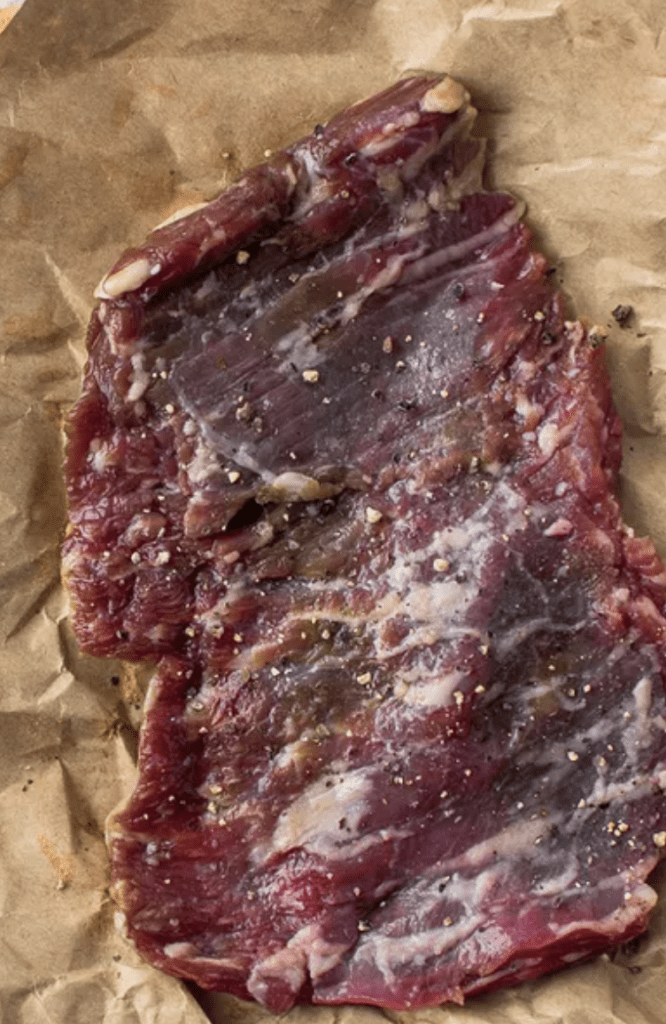
How to Cook Skirt Steak
Both outside and inside skirt have a good amount of fat within and between the muscle strands, which helps keep it moist when grilling. The grain on the inside skirt is a little bit wider, so it might have slightly more fat.
A lot of skirt steak recipes call for marinating the meat before grilling it, and because of its looser structure, skirt steak will absorb the flavors of the marinade quite well. But there’s no need to marinate it for more than 30 minutes.
Since skirt steak is tough, the best way to cook it is very quickly over the hottest grill you can get. As a matter of fact, some people will even skip the grill altogether and cook it directly on the coals. This actually works quite well, because you do not want to overcook skirt steak. Cooking it directly on the coals gets the surface of the meat nice and brown very quickly, without cooking the inside of the meat for too long. Ideal doneness is medium-rare to medium.
How to Select Skirt Steak
You should be able to find skirt steak in the meat department of your supermarket, more often the inside skirt versus the outside skirt (but may be labeled simply as “skirt steak.”) Most of the surface fat should have been removed by the butcher.
Although skirt steak and flank steak are two different cuts of meat, the two are referred to interchangeably. But they should both be labeled separately as such.
The Most Popular Steaks – Strip Steak
Strip Steak is a very tender cut of steak taken from the loin and also referred to as New York Strip Steak.
The strip steak, also called a New York or a Kansas City strip, is considered among the higher-end cuts of beef, along with the filet mignon, the rib-eye, and the porterhouse or T-bone steak. The strip steak comes from the beef short loin subprimal and it starts off with a short loin that has had the tenderloin removed, to produce a bone-in strip loin.

How to Cook Strip Steak
Strip steaks are easy to cook on the grill, under the broiler, or in a cast-iron skillet on the stovetop. You can also sear them in a skillet and then transfer it to a preheated 425 F oven to finish cooking.
Let the steaks come to room temperature on the counter for at least 30 minutes before you cook them so they cook evenly. Pat them dry with paper towels so you can get a good sear quickly. And don’t be afraid to use some butter with this leaner cut.
How to Select Strip Steak
Whether you buy strip steaks pre-packaged at the grocery store or freshly cut from a butcher, look for the ones cut from the rib end or the center of the strip loin. It’s easy to tell the difference by looking at the shape of the steak.
Look for a cut that’s wide and relatively straight, without much difference in width from top to bottom. The fat around the edge should be trimmed to about 1/8 of an inch all the way around. Avoid steaks that are kind of wavy, or shaped like a question mark, or have one end that is substantially more narrow than the other. These are from closer to the sirloin end and less desirable.
Indeed, you might even see something called a “center-cut” strip steak, which sounds like it must be from the center. But all it means is that it can’t be the last one from the sirloin end.
The Most Popular Steaks – T-Bone Steak
Named for the T-shaped bone that connects a piece of top loin with a piece of tenderloin, T-bone steaks are worthy of a special occasion. Great for grilling, the filet side should always be angled the farthest away from the flame to prevent over-cooking. T-bones, cut from the front section of the cow’s short loin where the tenderloin narrows, command a premium price as popular special-occasion orders at upscale restaurants.
Crosscut from the forward section of the short loin on a steer’s middle back, a T-bone steak contains a strip of the top loin and a chunk of tenderloin, both desired cuts on their own. A T-shaped bone from the lumbar separates the two pieces. The tenderloin filet on the larger porterhouse cut—essentially the same steak but for the size—must be at least 1 1/4 inch at the widest point to qualify for the designation; the rules say a T-bone must have at least 1/2 inch.
The T-bone combines the meaty flavor of a strip steak, often called a New York strip when it’s sold on its own, with the signature tenderness of the filet mignon. The premium price reflects its position on the animal, coming from the area along the spine with the least used muscles. T-bones come cut at least 1-inch thick, though it’s not unusual to find 1 1/2- to 2-inch-thick steaks.
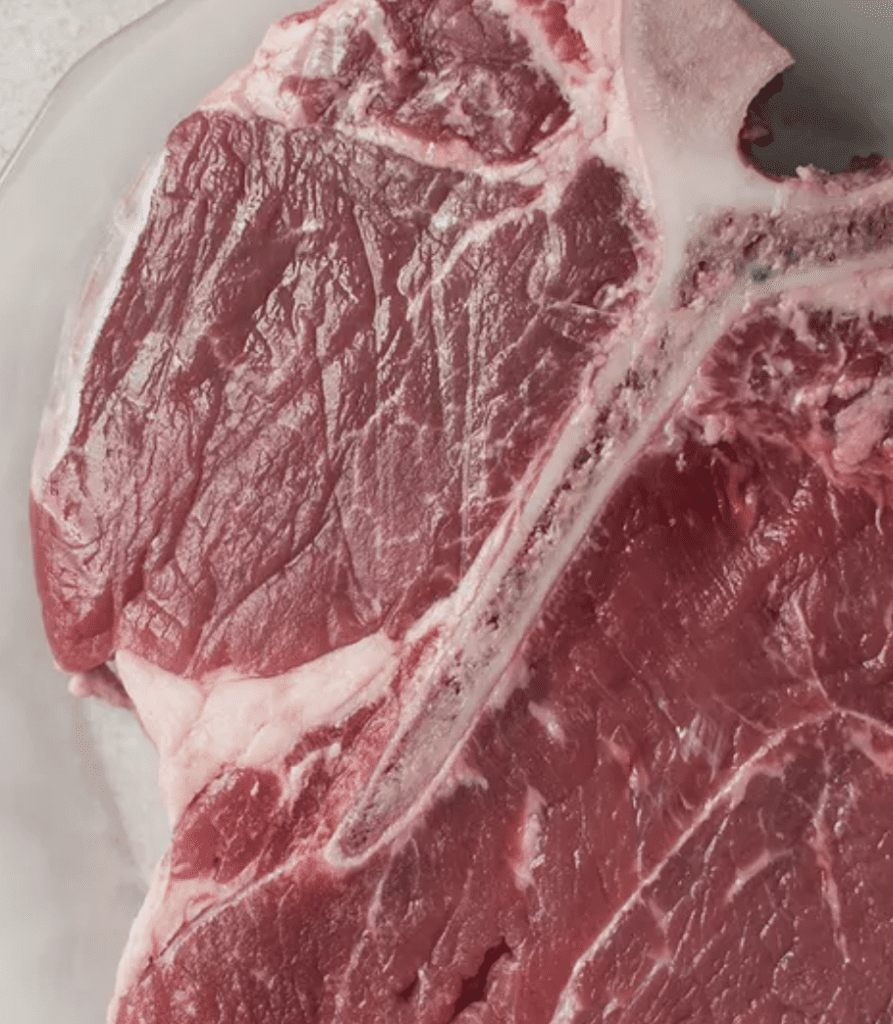
How to Cook a T-Bone
The T-bone is made for grilling. Generous bits of fat keep it moist while the tenderloin heart stays tender and flavorful. The intact bone provides a sturdy handle to grab the steak and flip it without puncturing the meat and losing flavorful juice or sparking a flare-up. Stereotypically, this good-looking steak stars on backyard grills in commercials and is often a favorite of the outdoor chef.
The steak needs little adornment and should be lightly oiled, judiciously seasoned, and cooked hot and fast. It is important to note that the slowest cooking portion of this cut sits right in the bend of the bone near the base. This area will remain rarer than the rest of the steak. The fastest-cooking portion, the filet, should be positioned farthest from the fire or it can end up overdone by the time the strip cooks through.
It’s possible to cook a T-bone in the kitchen, with the stovetop-to-oven method yielding the best results. Start with a quick sear in a smoking hot cast iron or another ovenproof skillet, then transfer the steak to a 425 F oven until it reaches the desired doneness, from five to 15 minutes depending on the thickness of the cut. Use an instant-read thermometer for the most accurate temperature, and gauge it in a section of meat located away from the bone.
Most steakhouses cook beef over open flames, and the T-bone makes a good candidate for your backyard grill. Take care, though: The leaner tenderloin cooks more quickly than the strip side of this dual cut, so you need to keep it farther from the flame to achieve your desired doneness for the meat on both sides of the bone.
How to Select a T-Bone Steak
Look for T-bone steaks at your grocery store or a specialty butcher shop. This popular cut commands premium prices, but compared to the cost at a steakhouse, a home-cooked steak dinner is an affordable way to treat yourself to an upscale meal.
Avoid anything labeled as “thin-cut;” a T-bone steak should ideally be at least 1 1/2 inches thick. If you cannot find anything in the meat display, ask the butcher to cut it to order.
The Most Popular Steaks – Tri-Tip Steak
This steak is a triangular cut from the bottom sirloin and is built for the grill. The boneless cut of beef is flavorful but economical, and is best when it’s not over-cooked.
Originally called a California cut, the tri-tip steak has become increasingly popular because of its superior flavor. The tri-tip steak is cut from tri-tip roast which is part of the bottom sirloin subprimal cut. It is an economic piece of meat that is full of flavor—it is far less expensive than other equally flavorful steaks such as the rib-eye.
The tri-tip has excellent marbling (the fat running through the meat) and is very tender as long as you don’t overcook it. Tri-tip is built for grilling, but it can also be cooked in a hot skillet on the stovetop. This steak is simply cut pieces of the triangular tri-tip roast, which is why it is also known as triangle steak.
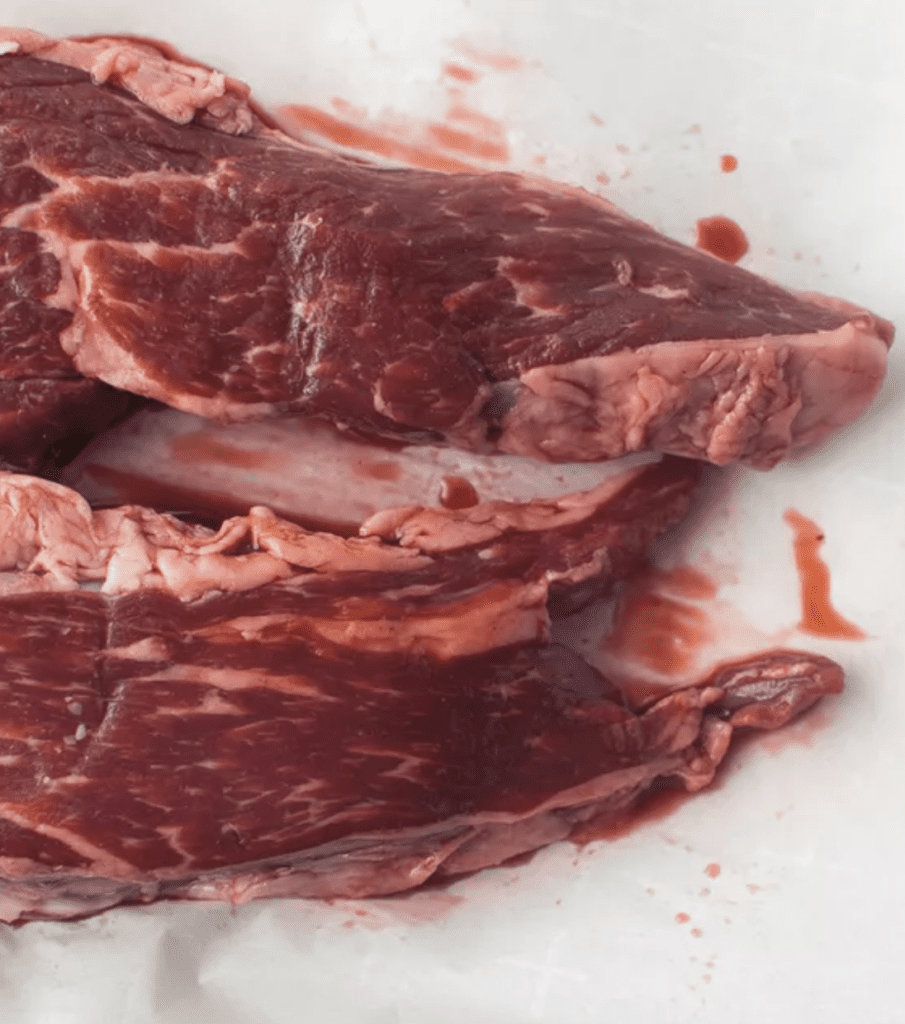
How to Cook a Tri-Tip Steak
This cut benefits from quick cooking methods, such as grilling, broiling, and pan-searing. Since it is a lean cut, if you are going to take this steak beyond medium, then you should probably marinate it two to three hours before you plan to cook. You can also season the steaks with a spice rub. Grill 1-inch steaks 15 to 17 minutes and broil for 11 to 12 minutes (flipping once) for medium. If using the stovetop, heat a heavy skillet (cast iron is great) with a little oil until hot; add the steaks and cook, turning over once, for about 12 minutes for medium.
How to Select a Tri-Tip Steak
Unfortunately, in many areas across the country, the tri-tip steak is not available. This is because this part of the cow is typically cut differently by regional butchers. If you cannot find tri-tip in the meat section, talk with your butcher—some may have it, but know it by another name. (Ask for a California or Santa Maria cut and see if that helps, but it can also be called culotte steak, bottom sirloin tip, or Newport steak.) Any good butcher should be able to cut tri-tip steaks for you, and if they don’t do that kind of cutting, you need to find a different butcher.

